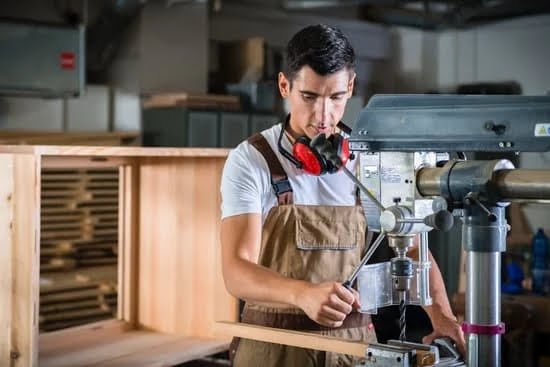Introduction
A woodworking straight edge is a tool used by woodworkers to ensure that wood pieces are cut accurately. It is an essential part of a carpenter’s toolkit and can be used in conjunction with other cutting tools such as saws, routers, jointers and planes. The straight edge is placed against the wood to provide a true reference line that allows a carpenter to align, mark or measure the material. By using a straight edge and other cutting tools together, errors can be minimized during the manufacturing process and finished products will meet exacting standards.
A woodworking straight edge comes in different lengths and styles, allowing for various tasks to be completed accurately. Depending on its purpose, it may have markings added along its length for more precise measurements such as ebony pins, radii lines or tapered edges. Many straight edges are constructed from aluminum or stainless steel for durability and accuracy but sometimes plastic or wooden versions may also be used when working around delicate components such as veneers or laminates.
When using a woodworking straight edge it is important to check for any damage before use including chips along its edges which would affect accuracy. Also consider protective measures where necessary including applying masking tape around workpieces when making long cuts with handtools ensuring that saws do not slip off the straight edge during use. Finally, keep your tool clean and store away properly when not in use to ensure maximum performance over time.
Different Types of Woodworking Straight Edges
There are many different types of woodworking straight edges, each with its own set of advantages and disadvantages. The most common types are aluminum carpenter’s squares, steel rulers, wooden rulers, and specialty edge guides.
Aluminum Carpenter’s Squares: These lightweight tools have a square shape that comes in many sizes, ensuring accuracy at any angle of measurement. Aluminum carpenter’s squares come with a built-in ruler marked in both imperial and metric measurements for added convenience. Advantages include their accuracy, portability and affordability. However, they may not be as durable as other option since they can easily bend or dent.
Steel Rulers: Steel rulers are heavier and designed to last longer than aluminum carpenters squares ” making them ideal for more frequent use within a workshop or on the job site. They come in a variety of sizes to suit your needs but may be difficult to read because the numbers seem tiny compared to the size of the ruler itself when larger measurements are made. Steel rulers also do not offer accuracy at different angles like an aluminum carpenter’s square does.
Wooden Rulers: Wooden rulers are often preferred by those who work with small projects because they make precise measurements much easier than metal rulers due to their smaller size and angled edge which allows them to be held steadier when measuring long lengths of wood or tracing line measurements accurately. Disadvantages include being less accurate than other options, being sensitive to moisture which can cause warping near the end grain of the ruler, and being prone to damage if dropped onto harder surfaces such as stone or concrete flooring.
Specialty Edge Guides: Specialty edge guides feature adjustable marking arms perfect for making repeat cuts ” allowing you even more accuracy when detailing delicate moldings or working with shaky hands without sacrificing precision. One downside is that these more complex tools come at a higher price point than other options available on the market today due to their higher quality materials constructionand additional features such as dust collection slots for smoother clean up during operation time.
Benefits of Using a Woodworking Straight Edge
A woodworking straight edge is an essential part of any tool kit. It is used to accurately cut and measure wood products, creating smooth and precise results. The straight edge not only assists with accuracy but can also improve the speed of projects. When using a straight edge, there’s no need to pause and search for a ruler or other measuring device. Additionally, by taking greater control over the cuts you make, you can reduce waste by avoiding excess sawing and material loss due to crooked improvements.
Having a good quality straight edge also ensures better-quality results from your work. With its more reliable accuracy than freehand cutting, you can create even edges much easier than before. In addition, having a tool with near-perfect accuracy on hand will take out some of the guesswork when working to specific sizes or angles — which are often necessary for certain joints in furniture making. This greatly improves the finishing of your project in comparison to freehand cuttings which lack precision and all rarely look absolutely flush on the final piece.
How to Properly Use a Woodworking Straight Edge
1. Select a straight edge that is appropriate for the job. When choosing a straight edge, it is important to select one that is strong enough to bear any pressure or weight during use. Choose a model made from metal or plastic if you are using it on thicker and wider surfaces, while aluminum models can be used on thin and narrow surfaces.
2. Prepare your workspace by placing an even surface underneath the materials you intend to measure. This should be smooth, flat and stable so that your tools won’t slip during use.
3. Securely fasten the material being measured in place using clamps or other suitable fixtures so as to prevent any movement during the measuring process.
4. Position the chosen straight edge along the length of the material in question, making sure that it is firmly aligned with the edges at one end but not yet resting against them at the other end – this will enable you to determine precisely whether or not those edges are indeed straight.
5. Slowly glide the straight edge across its entire span, carefully pushing down as you go until you have determined that both ends of the material being measured match up evenly with one another – this should confirm that these two measurements are truly level with each other and make it easier for you to accurately evaluate any further cuts or markings along their length if necessary.
6: Once complete, inspect your results and take note of any irregularities by eyeballing them against one another – this will give you an idea of how far off they might be so as to understand what type of adjustments may need to be done next before continuing with your project.
Tips for Improving Accuracy with a Woodworking Straight Edge
1. Start by making sure your straight edge is the right size for the job you are doing. A too small edge will be difficult to use for larger pieces of wood, and a too big edge will be hard to maneuver around smaller pieces and into corners.
2. For best results, make sure that your straight edge is perfectly flat on both sides as any curved edges can cause inaccurate cuts in the wood. You want your straight edge to move smoothly along its range with ease, avoiding any bumps or snags.
3. Place your straight edge on the surface of the wood you are working with, double-checking its position so it is aligned properly before beginning your cutting project. This can be done visually or by using measuring tools such as a ruler or square to ensure accuracy.
4. Securely attach clamps alongside your straight edge on each side to keep it in place while you work; this prevents any slipping, shifting or warping which can all lead to inaccurate measurements and undesired outcomes in the finished product.
5. To cut along the length of a board without error, use two hands: one hand guiding the top end of the board along with your straightedge and one hand pushing at a steady speed from behind so that you don’t jam or break your saw teeth when cutting into harder woods such as oak or walnut.
6. For best results, it’s essential to clean off accumulated sap from saw marks and smooth them out using fine-grit sandpaper after each cross-cut; this ensures further precision in following steps and better appearance in final projects down the road.
How to Clean and Store a Woodworking Straight Edge
Cleaning your woodworking straight edge is an important task, particularly if you work with solid wood. Woodworking is a messy business and it is essential to keep the edges of your tools sharp and clean in order to ensure the quality of work you are producing is at the highest standard possible. To clean a straight edge, start by dusting off any dust that has accumulated on the blade. For tougher dirt or residue, use a damp cloth or a soft-bristle scrub brush and some mild soap. When cleaning is complete, make sure all moisture is removed with soft towels or paper towels. Once clean, apply some oil to the blade to stop rusting and keep its shine.
When storing your woodworking straight edge, make sure it’s stored in a way that will not cause damage to the handle or blade. If stored upright on a shelf, put something underneath it such as rubber sheeting or felt pads so it does not scratch other objects on the shelf. Make sure that any handles are kept in their original packaging so they don’t get too rough over time from rubbing against other objects in storage. It’s also best to store them away from sources of moisture such as humid basements or steamy bathrooms because this can lead to rust build-up on the blades which will cause them to wear down more quickly and reduce their lifespan significantly. Finally, when storing your woodworking straight edge for longer periods of time (months), wrap them loosely in a plastic bag and store them in a dry place such as an attic or closet where temperature changes won’t affect them too much.
Conclusion
A woodworking straight edge is a must-have tool for any woodworker. It provides a reliable and efficient way to get accurate measurements for cutting, routing, or laying out projects. Using a wooden straight edge helps prevent mistakes by providing perfectly straight lines. Beginners to advanced woodworkers both benefit from the accuracy provided by using a wooden straight edge. Furthermore, it is lightweight and easy to store when not in use. With a wooden straight edge, anyone can create professional looking projects with ease.

Hi everyone! I’m a woodworker and blogger, and this is my woodworking blog. In my blog, I share tips and tricks for woodworkers of all skill levels, as well as project ideas that you can try yourself.





